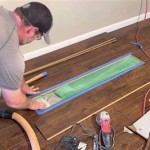All About Snap Lock Flooring: A Comprehensive Guide
Snap lock flooring, also known as floating or click flooring, has gained immense popularity as an easy-to-install and versatile flooring solution. It offers numerous advantages and is a great option for both residential and commercial spaces. This guide will provide an in-depth overview of snap lock flooring, exploring its key aspects, benefits, and installation process.
Benefits of Snap Lock Flooring
Easy Installation: The snap lock mechanism makes installation a breeze. Each plank has interlocking edges that simply snap together without the need for nails, glue, or specialized tools.
Floating Floor System: Snap lock flooring is a floating floor system, meaning it is not permanently attached to the subfloor. This allows it to expand and contract with changes in temperature and humidity, reducing the risk of buckling or warping.
Durability: Snap lock flooring is typically made from high-density materials, making it resistant to moisture, scratches, and dents. It is also durable enough to withstand heavy foot traffic.
Versatility: Snap lock flooring comes in a wide range of materials, including laminate, vinyl, and engineered wood. This makes it suitable for various decor styles and can be installed in different areas of the home or office.
Choosing Snap Lock Flooring
When selecting snap lock flooring, there are several factors to consider:
Material: Choose a material that suits your specific needs and preferences, such as laminate for durability, vinyl for moisture resistance, or engineered wood for a natural aesthetic.
Thickness: The thickness of the planks affects their durability and stability. Thicker planks are more resistant to damage and can withstand heavier traffic.
AC Rating: The AC rating indicates the wear resistance of the flooring. A higher AC rating signifies a more durable floor that can withstand heavier use.
Warranty: Look for flooring with a substantial warranty to ensure its longevity and protection against defects.
Installing Snap Lock Flooring
Installing snap lock flooring is relatively straightforward, but it is essential to follow the manufacturer's instructions carefully.
Preparation: Start by preparing the subfloor. It should be level, clean, and dry. If necessary, install an underlayment to provide additional cushioning and moisture protection.
Laying the Planks: Begin by installing the first row of planks along a straight wall. Lock the planks together by aligning the edges and snapping them into place. Continue laying subsequent rows, ensuring the joints are staggered for stability.
Trimming: Use a circular saw or jigsaw to trim the last row of planks to fit. Make sure to leave a small gap around the perimeter of the flooring to allow for expansion.
Installation Completion: Once all the planks are in place, install the baseboards or quarter rounds to cover the expansion gaps and complete the installation.
Conclusion
Snap lock flooring is an excellent choice for those seeking an easy-to-install, durable, and versatile flooring solution. With its numerous benefits and wide range of options, it is suitable for various applications, from residential homes to commercial spaces. By following the proper installation guidelines, you can enjoy a beautiful and long-lasting snap lock floor.

Snap Lock Flooring Tips For Pros Learning Centerlearning Center

Essential Tools For Snap Lock Wood Flooring Learning Centerlearning Center

Essential Tools For Snap Lock Wood Flooring Learning Centerlearning Center

Lock Vinyl Plank Flooring A Comprehensive Guide Floorings

How To Install Lock Engineered Hardwood Flooring

Snaplock 24 Pack 12 In W X L 0 5 Mm T Garage Floor Corners The Flooring Edges Department At Com

How To Install Laminate Floors

Tradeshow Display Snaplock Classic Teak Floor System

Tranquility Ultra 5mm River Walk Oak Waterproof Luxury Vinyl Plank Flooring 6 In Wide X 48 Long Ll

Lock Glueless Hardwood Flooring
See Also







